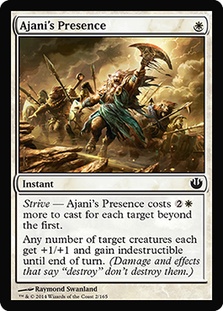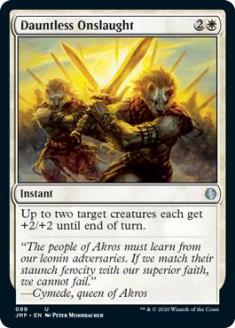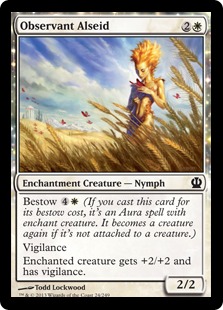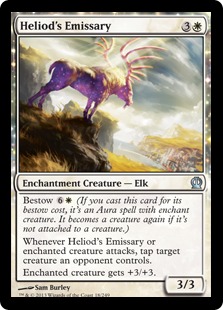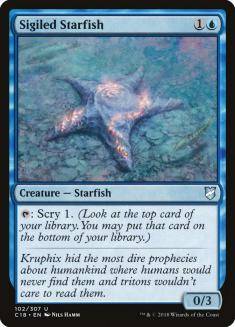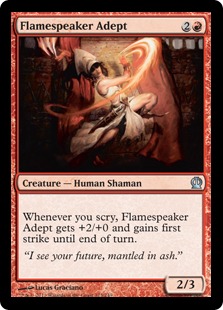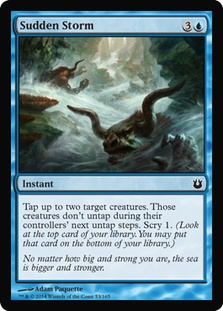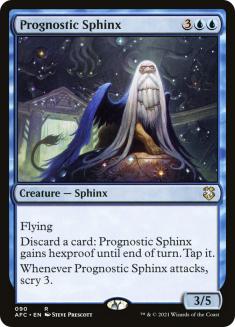On Thursday
Me: “I’ve got a good feeling about this weekend. I think I’m going to win the PTQ.”
Forrest: “You said that before the last two PTQs.”
Me: “Well, I thought I was going to win those too!”
On Improvement
My finishes in the previous two PTQs were tenth and third, losing a win-and-in in the former and falling in the semifinals when a lethal fifth land never
showed up. While unsatisfied, I had been in above average shape to win both events: I’d opened strong Sealed decks and built them within a couple of cards
of perfection. I’d been very happy with my play in the event I lost in Top 4, but I was a bit boneheaded in the early rounds of the other one; those
mistakes didn’t cost me a match, but they were instructive regarding my mental faculties on diminished sleep, as I’d driven into Vegas and stayed up rather
late the night before.
Apparently, I am getting too old for this $#!+ after all.
Memorial Day weekend and the first weekend in June would be my last opportunities to play for Portland, and I resolved to make the most of them. I
practiced drafting and saw my results improve: during a reunion with college friends I dropped two matches over five team drafts, and my MTGO efforts also
went well.
The weakest aspects of my JBT drafting had been my eagerness to have a solid two-color strategy by the end of Pack 1 and my tendency to underdraft
creatures. I shifted to finding one color I could really move into and allowed the second color to make itself known. I skewed my early picks toward the
most powerful cards first and on-color cards second, favoring proactive strategies with under-drafted synergies. For example, my B/W decks would often
feature Dreadbringer Lampads and Mortal Obstinancy, while my blue decks would frequently feature some Breaching Hippocamp shenanigans via inspired or
Retraction Helix. Being able to integrate these cards effectively went a long way towards ensuring I had plenty of playables, sideboarding options, and
enough warm bodies to close out games.
I felt pretty confident in my Sealed abilities, so I didn’t practice that much at all.
On Misbuilding
Naturally, that led to me misbuilding this weekend’s Sealed Deck by twenty cards – most impressive. I’ve rebuilt the pool from memory; I can guarantee that
the 54 relevant cards are 100% correct, but I’ll admit I might be off on a few of the others. It really doesn’t matter, as there are only two rational ways
to build this pool, by my estimation.
- 1 Grisly Transformation
- 1 Gray Merchant of Asphodel
- 1 Loathsome Catoblepas
- 1 Stormchaser Chimera
- 1 Forsaken Drifters
- 1 Sphinx’s Disciple
- 1 Lost in a Labyrinth
- 1 Annul
- 1 Satyr Firedancer
- 1 Desecration Plague
- 1 Mana Confluence
- 1 Stonewise Fortifier
- 1 Vaporkin
- 1 Omenspeaker
- 1 Flamespeaker Adept
- 1 Wild Celebrants
- 1 Excoriate
- 1 Nyxborn Triton
- 1 Setessan Battle Priest
- 1 Setessan Starbreaker
- 1 Humbler of Mortals
- 1 Bassara Tower Archer
- 1 Starfall
- 1 Thassa’s Devourer
- 1 Nessian Demolok
- 1 Thunderous Might
- 1 Font of Vigor
- 1 Desperate Stand
- 1 Archetype of Aggression
- 1 Noble Quarry
- 1 Hold at Bay
- 1 Stormcaller of Keranos
- 2 Aspect of Hydra
- 1 Akroan Hoplite
- 1 Prognostic Sphinx
- 1 Shrike Harpy
- 1 Renowned Weaver
- 1 Flurry of Horns
- 1 Ajani’s Presence
- 1 Psychic Intrusion
- 1 Ordeal of Purphoros
- 1 Gluttonous Cyclops
- 1 Harvestguard Alseids
- 1 Magma Jet
- 1 Aerial Formation
- 1 Arena Athlete
- 1 Market Festival
- 1 Font of Return
- 1 Heliod’s Emissary
- 1 Asphodel Wanderer
- 1 March of the Returned
- 1 Kraken of the Straits
- 1 Dauntless Onslaught
- 1 Nyx Infusion
- 1 Culling Mark
- 1 Dragon Mantle
- 2 Sudden Storm
- 1 Magma Spray
- 1 Scourgemark
- 1 Eagle of the Watch
- 1 Charging Badger
- 1 Sigiled Starfish
- 1 Vulpine Goliath
- 1 Spirit of the Labyrinth
- 1 Rise to the Challenge
- 1 Dreadbringer Lampads
- 1 Satyr Rambler
- 1 Pheres-Band Warchief
- 1 Fearsome Temper
- 1 Wingsteed Rider
- 1 Epiphany Storm
- 1 Observant Alseid
- 1 Two-Headed Cerberus
- 1 Nessian Game Warden
- 2 Kragma Butcher
- 1 Kruphix’s Insight
- 1 Weight of the Underworld
- 1 Lightning Strike
- 1 Bladetusk Boar
- 1 Necrobite
- 1 Blinding Flare
The two best color combinations are clearly W/R and U/R. Red is the deepest color, and it has access to some of the most efficient removal in the format
between Magma Spray, Magma Jet, Lightning Strike, and technically Ordeal of Purphoros. Bladetusk Boar and Fearsome Temper both offer brutal ways to get
through typical opposing defenses, and Kragma Butcher is a top-tier three-drop in the format. So how do you decide which color to pair it with?
For me, the decision came down to these cards:
Against these cards:
I built the blue deck first, as I had a lot of experience with U/R and knew it wouldn’t take long to find the best build. I had about 21 cards I was very
excited about for that deck and a handful of others I could consider playing. I knew that W/R had more easy playables – Arena Athlete was actually a card
in W/R, and there were a couple more good cards in white – so I went about building that deck.
It was tough. I considered playing sixteen lands, as I very much wanted to play Two-Headed Cerberus and Dragon Mantle but had no interest in playing one
without the other… but in the end I couldn’t justify trying to play two 1RR drops in my Wingsteed Rider and Ajani’s Presence deck on such a low land
count. I wound up “splitting the difference” a bit and playing Mana Confluence as my seventeenth land, rationalizing that I wouldn’t take much damage in
games I flood and that the games in which I’m land-light and spell dense would frequently be slaughters. Here’s the deck I registered:
8 Mountain
8 Plains
1 Starfall
Sideboard:
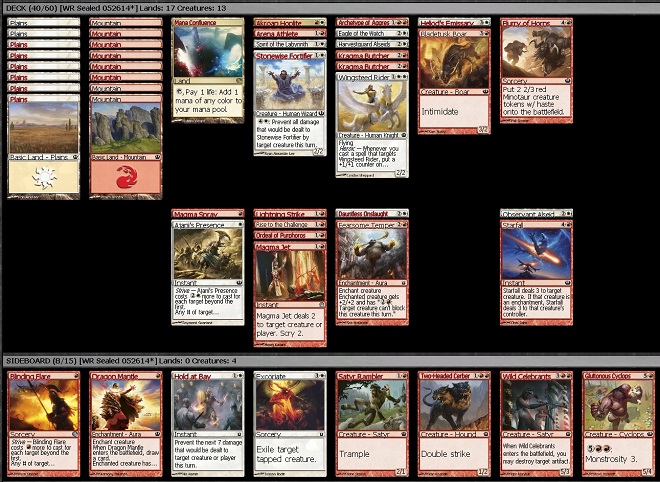
I’ve included screenshots because it’s easier to parse Limited decks that way.
The W/R deck had a higher density of strong cards and could be a lot more aggressive than most Sealed decks are designed to handle, which was a major draw
to the deck. I figured I’d play W/R Game 1, blitz them, and then frequently side into U/R in order to take advantage of them boarding in defensively minded
cards that the U/R deck would easily ignore.
Here’s the deck I wound up transforming into for every sideboarded game:
8 Island
1 Vaporkin
9 Mountain
Sideboard
1 Annul
1 Starfall
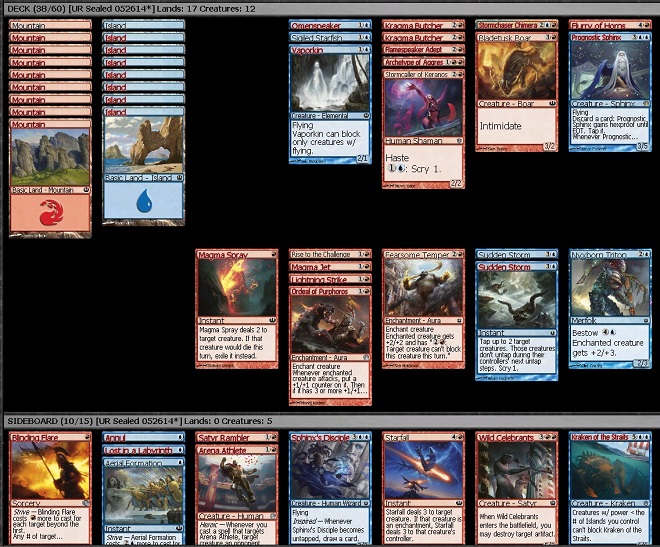
Savvy readers will notice that the main is a couple cards short. That’s because the last two cards changed depending upon the deck I’d played against. The
most frequent cards played in these positions, in order, were Starfall, Annul, Blinding Flare, Wild Celebrants, Arena Athlete, and Aerial Formation. I
don’t recall sideboarding any of the other options in even once, but I’ll note that against U/B and slower B/R decks I like Sphinx’s Disciple, and against
deathtouch-heavy decks Lost in a Labyrinth is a useful trick to keep in mind, while Kraken of the Straits can attack past such creatures with ease.
After playing four rounds, I had become quite sure that the U/R deck was just better. The problem wasn’t that the W/R deck was bad – it’s that the field
would often already be maindecking many of the cards that were good against it. Fat green creatures like Snake of the Golden Grove and Vulpine Goliath are
very common to play against in Sealed, and bashing through those creatures without a flying monster is pretty difficult in white. As long as the opponent
draws their removal and aims it at your evasion creatures, it’ll be difficult to win.
By contrast, the U/R deck could both ignore the ground and exploit it, as the game required, thanks to those Sudden Storms and Kragma Butchers alongside
flying threats. One of the things that initially drew me to the U/R deck was its high density of scry and the power of Flamespeaker Adept in the deck, both
of which are not to be underestimated. Turn 2 Starfish into Turn 3 Adept is a brutal opening, and Stormcaller of Keranos makes the guy borderline
unkillable in combat.
One of the cards I played in both of these decks that I don’t normally like very much is Flurry of Horns. I’ve died to my fair share of “2 fast 2
flurrious” Minotaurs, but my opinion of the card is that it’s quite marginal; however, in these decks, it’s an easy inclusion. The W/R deck loves being
able to swarm the board past a singleton creature, chump-attacking for damage to get the opponent in range of Lightning Strike or Bladetusk Boar, while the
U/R deck can curve Sudden Storm into Flurry for one and maybe even two unopposed attacks with the Minotaurs and any other creatures you have lying around.
On Playing Magic
My Swiss rounds weren’t especially interesting. I mulliganed a lot of Game 1 hands, a result of the mana instability in that W/R deck, and I think I went
about 50% in Game 1s. I successfully ferreted out a Divine Verdict I hadn’t seen before during Round 2 (spidey-senses tingling) and took
advantage of greedy timing on opposing Retraction Helixes at least three, if not four, times over the course of the event by using Sudden Storm to counter
it. This interaction is easy to get caught by, so keep in mind when playing against blue and red opponents that there are many commons capable of blowing
you out.
I took my first loss in Round 5 to Scott Freeman. I leaned heavily on an Archetype of Aggression to keep two large tramplers at bay in our final game, when
a very interesting situation arose. I’ll illustrate the board state here, during Scott’s turn:
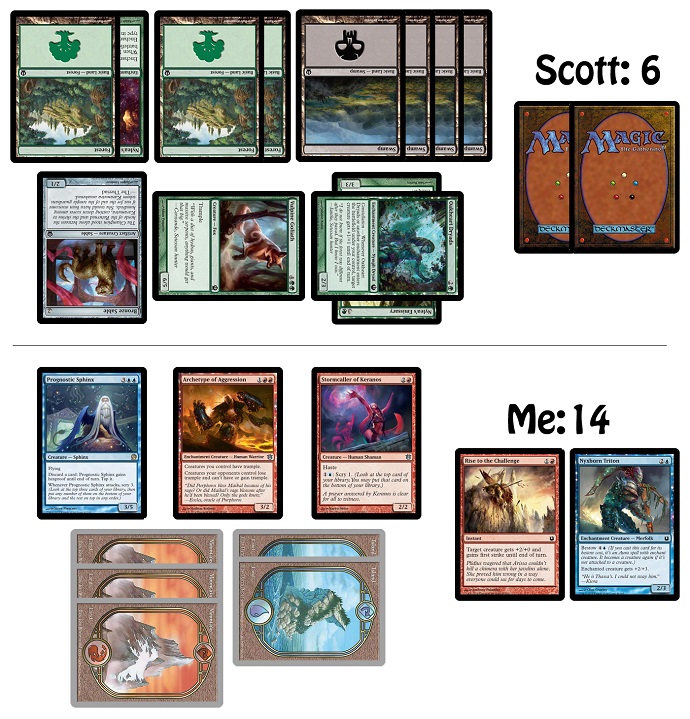
Some additional information:
I died in the previous game to Colossal Heroics followed by Herald of Torment. I took an early lead in this game, inching in damage, but had been stuck on
four lands for some time and been unable to cast spells and use Stormcaller while Scott’s board continued to improve. At one point, I attacked Archetype of
Aggression and none of my two-power creatures into Vulpine Goliath, effectively painting Rise to the Challenge on my forehead. I’d also bluffed a Titan’s
Strength earlier, but that attack mostly guaranteed he would not believe I had it anymore.
Over the last couple of turns, Scott had been trying to get aggressive and doing math before attacking each turn, leading me to believe he had an expensive
or unwieldy pump spell in his hand – both Herald and Heroics fit the bill at first, but I’d become pretty sure it wasn’t Herald, so when he made this
attack I went deep into the tank.
See, Scott knew I had Rise to the Challenge, which meant that unless he had a pump spell to make this attack lethal or a creature with toughness four or
greater, he was dead on the board to me declaring no blocks and cracking back with Rise to the Challenge. Other cards (like most Disenchant) would
certainly beat me, but all of those cards would beat me a lot of the time without a topdeck on my end regardless of how I played, so there wasn’t much
merit to considering those potential realities.
In the end, I decided to block his Goliath with my Stormcaller, going to nine life and hoping I could kill him with two Sphinx attacks while chumping or
topdeck Sudden Storm, Lightning Strike, Fearsome Temper, or Ordeal. This block defeats Colossal Heroics unless he adds a creature with reach or 3+ power to
the board, and there are several black creatures that meet the “four toughness to live through Rise” requirement while failing the “three power to kill
Glenn” requirement.
His spells turned out to be Felhide Minotaur and the pump spell was Mischief and Mayhem, so I died to the swing back on his next turn anyway when not
blocking would’ve given me lethal. Scott admitted he’d figured out the Rise to the Challenge but simply forgotten to account for the Archetype’s ability to
force through a point of damage against his creatures; however, I think his attack is likely correct even if he had remembered – it’s very difficult for me
to assume an opponent who has played well throughout the match would leave himself dead to a known trick here, and making me chump decreases his odds of
dying to random garbage like Flurry of Horns.
On Procrastinating
I’m really glad I didn’t email Cedric my “Sea’s Claim in Modern” article on Sunday morning.
On Drawing into Top 8
While my situation was easy – approximately half of my opponents were playing for Top 8 over the last two rounds, giving me incredible tiebreakers – things
got more complex farther down the standings. My roommate Forrest was the seventh seed (58.05%) while my Round 2 opponent Chris was the eighth seed
(57.76%). They were the last of the players on 18 points, leaving a 16-pointer named Jaime behind them on 56.63%.
This is a tough spot to be in – Forrest and Chris can draw, and they’re both favorites to make Top 8 if they do so. They’ll each be adding a 6-1-1 player
to their own tiebreakers, while the one player trying to crush them has to both win his match and also overcome a deficit of almost 1.5% while adding a 5-3
player to his own tiebreakers. If you assume the outcome of any given match is roughly 50%, you can say that drawing locks them for Top 8 half the time
(every time Jaime loses) and that they’ll still Top 8 a significant percentage of the time that Jaime wins his match – probably more than half that time.
You can give or take, but rough estimate is that they’re 75% favorites to both Top 8 with a draw and that one of them will always Top 8 – the math favors
Forrest very slightly, but that’s like saying your really old quarter flips a little funny.
Their other option, of course, is to play. If they play, one of them will still be guaranteed to make Top 8 – it’ll just be the match instead of favorable
math that decides which player that is. The losing player will be eliminated whether Jaime wins or loses, as there are some unbeatable tiebreakers among
those 5-2s. If either Forrest or Chris think they’re going to beat the other over 70% of the time, choosing to play is a fine option… but that’s a bold
claim, Cotton.
I explained my view on the math to Chris and Forrest while we waited for official pairings, and told them they should do whatever felt right to them but
that I’ll almost always draw in that spot with a PTQ Top 8 on the line because all I’m trying to do is get to the draft alive. It’s a tough spot for Chris,
and I told him to take my advice with all due grains of salt – Forrest would have a slight edge on Chris if it came down to a tiebreaker race against
Jaime, meaning Chris is slightly more likely to wind up screwed than Forrest.
They agreed to draw, and we all went to Chipotle. I loaded up on caffeine now that we’d hit the home stretch and, as usual, proffered the cost of our meals
to Forrest on a coin flip. He won the flip to eat for free, and I pointed out this was a real crappy spot to use up the last of his run-good.
When we got back to the store, he’d been jumped on tiebreakers by both Jaime and Chris, leaving him in ninth place and outside of the Top 8 by
0.06%.
Awkward.
On Drafting
I started the draft with Doomwake Giant over some interesting but not fantastic cards, assuming Strength from the Fallen would wheel if I saw a Nyx Weaver
or something along those lines but really just hoping to snag Pharika’s Chosen ninth. I was passed foil Heroes’ Bane, Hubris, and Mogis’s Warhound with the
rare missing, and took the Warhound without much deliberation. The Bane is a fine man, but he’s really just a giant monster in a color filled with them.
The Warhound was an enchantment for my Doomwake Giant and offered up a color combination I (weirdly) enjoy drafting, B/R. I know how to draft red decks in
the format and felt like my area of the table might favor green as both players to my left and right had played green in the Swiss rounds.
Also, I had the third seed and wanted to make the most of it – Mogis’s Warhound is a real bruiser on the play.
I mostly stayed in red after taking a Sigiled Starfish, jumping on a Satyr Hoplite and Flamespeaker’s Will but getting preoccupied by a late Oreskos
Swiftclaw that I eventually passed. Most of the black cards I’d hoped to wheel didn’t – Chosen, Bloodcrazed Hoplite, and Grim Guardian all disappeared,
although I did wheel one of the two Nyx Infusions. The red was piping in strong, with Starfall and Flurry of Horns coming very late. I got both of the
Strength from the Fallens that were opened, but I assumed it was more that the people to my right didn’t think the card was any good as opposed to green
being open.
Pack 2 solidified me in black, as I got a Necrobite after taking Bolt of Keranos and picked up some more red creatures. This time, almost every black card
wheeled, and while they weren’t all-stars, they were playables. The cherry on top was a literal 14th-pick Ragemonger, which I considered a good omen. While
nothing exciting, 2/3s for three are perfectly reasonable men and I wanted to guarantee I got out of here with warm bodies.
Things got strange in Pack 3, but in a very profitable way. Starting with Coordinated Assault, I followed with Flamespeaker Adept before getting passed not
one but two Hammer of Purphoros in successive packs. I did my due diligence, going wide-eyed, tanking, and chuckling to myself about the absurdity of the
world we live in as I windmill-slammed them into my deck, adding a Lightning Strike to the crowd shortly after. From there I grabbed some mediocre
creatures and strangely wheeled Pharika’s Cure, though neither Mogis’s Marauder nor Disciple of Phenax came around.
My creature base wasn’t the greatest, but I had strong spells and an aggressive game plan.
10 Mountain
1 Swamp
7 Swamp
Sideboard
1 Starfall
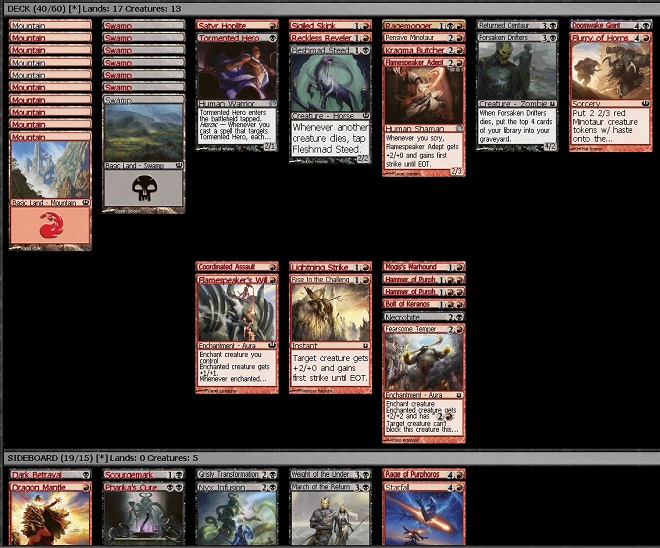
I hedged toward playing more creatures and less of the inefficient removal because I wanted to use my offense to create trades and damage, which Hammer
would be able to capitalize on as an unbeatable endgame. Weight of the Underworld was my final cut, though it may have been better than the Returned
Centaur I played over it. Most of the spells in my sideboard didn’t interact very favorably with paying three mana each turn for a 3/3, but I knew that
whoever took my other Satyr Hoplite, Impetuous Sunchaser, and Two-Headed Cerberus would force me to board those cards in and become more of a midrange
deck.
On Making Mistakes
Friday, I shaved my head.
#ReverseSamson
On Getting Lucky
The Top 8 itself wasn’t very interesting, although it contained several strong players with Neal Oliver concerning me the most. Not only does Neal have a
great resume in Limited events this year, but he’s also probably better than me and didn’t seem tired at all!
The first round saw me paired against Chris, who struggled with mana in both games before losing to Doomwake Giant and then the second Hammer in successive
games, his Returned Centaur having milled the first. The second round featured my opponent and myself both not realizing Heroes’ Bane doubled counters
based on power, not based on counters, so I attacked myself dead and won when he didn’t get me back in Game 1, and simply Doomwaked him to death in the
next game.
The finals pitted me against Neal, and I’d seen his deck play out during a lengthy match against Sam Stein while I waited for the finals. He had a very
aggressive R/W deck with access to Dragon Mantles, Archetype of Aggression, Two-Headed Cerberus, Searing Blood, and Fall of the Hammer. He had Forgestoker
Dragon to give him a good late game as well, so I planned to prioritize keeping his board clear and sideboarding in Swamps and my removal spells while
hoping I could overwhelm the Dragon.
Instead, Neal didn’t get to play much Magic. I opened on Satyr Hoplite into two-drop into a three-drop followed by the Warhound to supercharge my start and
enough tricks to prevent any of his blocks from ever being effective. In the second game, I kept a creatureless hand with two removal spells while Neal
mulliganed to five, and I promptly drew Sigiled Skink and Flamespeaker Adept to go from a slow start to the second nuts in two draw steps. Neal was a class
act and is only five points from Gold, so I wish him all the luck in that endeavor.
No one ever won a PTQ without getting lucky a few times. Forrest could only shake his head in disbelief.
On Winning
The last time I won a Pro Tour Qualifier was during an Extended (!) season for Pro Tour Honolulu. This was the same season as a PTQ win for Kyoto, and
within a year of my qualifying on rating (via a winning rate of over 90% in RoE draft) for Pro Tour Amsterdam. In 2010, I thought I was playing the best
Magic of my life up to that point, and I very likely was – three Pro Tours is a big deal.
While working at SCG in Roanoke, I became woefully aware of exactly how terrible I’d been in 2010. Playing with Gerry and Brad contributed a great
deal to changing how I thought about Magic, but honestly it was battling with Todd, BBD, and CVM that really fueled my ability to improve. Anyone who has
read Todd’s articles over the last few years knows how incredibly passionate he is about getting stronger at Magic, always pushing to do it better next
time. BBD and CVM are filled with that same fire, and watching BBD grow from “that guy who kept driving to Roanoke and beating me in our prereleases” to
the player he is today has been at times astonishing and always inspiring.
Living and working in Roanoke did a lot for my Magic game, and by the end of 2012 I knew I was worlds better than I’d been in 2010 – the difference was
very clear both internally and externally.
Which made it all the more frustrating that I was consistently failing.
Working coverage meant my time to play in PTQs was incredibly limited, as I had over thirty weekends each year dedicated to SCG. I made time when I could,
probably averaging almost two each season, but they just weren’t working out. A few unfortunate exits were really hammered home when my last East Coast PTQ
Top 8 ended with me mulliganing to four and still only losing to a four-outer with lethal on the board – in a PTQ where I only lost four games total.
After that event, I felt frustrated and defeated. I wasn’t just trying to beat my opponents in these events; I was competing with myself – a younger,
stupider version of myself – and I was losing to that moron!
I played six PTQs in 2013, and I did terribly in all of them. Often under-prepared and always pessimistic, I got exactly what I deserved and expected. I
checked out and gave up. I played MTGO, streamed, cubed, and felt pretty good about the Magic I was playing – I wasn’t playing in tournaments much, and
when I did it tended to not go very well, but I was winning a lot more than I was losing and liked the Magic I was playing, so I just stopped making
premier-level play a priority.
Since moving to Los Angeles five months ago, I’ve played a lot of tournaments. This was my sixth PTQ on the West Coast, and I’ve been doing well in the
local Constructed events. It’s a little awkward to be preparing for a Pro Tour for the first time in a few years about a month after I sold my MTGO
account, but the gods work in mysterious ways.

